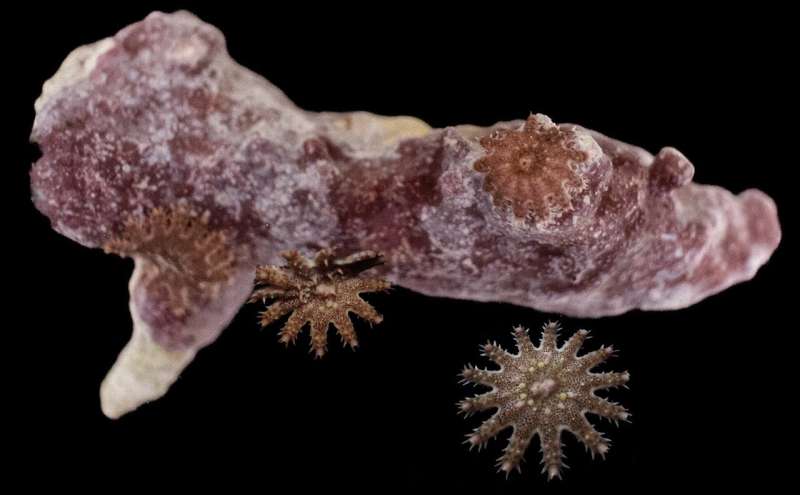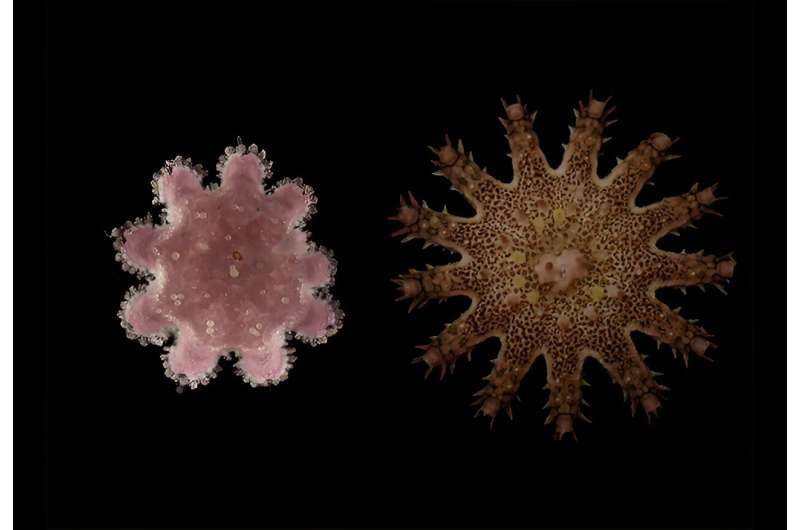This article has been reviewed according to Science X's editorial process and policies. Editors have highlighted the following attributes while ensuring the content's credibility:
fact-checked
peer-reviewed publication
trusted source
proofread
Reef-devouring predator survives coral bleaching and feasts on the survivors

Research conducted by marine biologists from the University of Sydney has found juvenile crown-of-thorns starfish can withstand tremendous heat waves well above levels that kill coral. These starfish then develop into carnivorous predators that devour reefs just as they begin to regrow.
Crown-of-thorns starfish are native to the Great Barrier Reef and found in the Indo-Pacific region, but they are classified as a species of concern because the damage large populations cause to coral is more significant than any other species. They fall behind only cyclones and bleaching events in their impact on coral mortality.
New findings suggest the species' resilience to warming waters could exacerbate the ravaging effect climate change has on coral reefs.
The research is published in the journal Global Change Biology, led by Professor Maria Byrne from the School of Life and Environmental Sciences. She is also a member of the Marine Science Institute and Sydney Environment Institute.
Over the course of the experiment, juvenile crown-of-thorns displayed a surprisingly high heat tolerance, higher than that observed in their adult counterparts. This means that even if the coral-eating adult stage declines in climate change-driven ocean warming scenarios, perhaps from a lack of their coral prey or from the heat, their herbivorous young can wait patiently for the opportune moment to grow into carnivores.
Coral bleaching and death can be triggered when waters warm by 1-3 degrees Celsius above the normal summer maximum, depending on how long the temperature lasts.
"We found juvenile crown of thorns starfish can tolerate almost three times the heat intensity that causes coral bleaching, using a model that measures temperature over time," Professor Byrne said.
"This is an important finding that has implications for understanding the impacts of climate change on marine ecosystems, especially the influence of understudied small cryptic species. Juveniles might well benefit from warming waters. The increase in the amount of their rubble habitat, generated by coral bleaching and mortality, allows their numbers to build over time."
The crown-of-thorns starfish is nature's ultimate coral predator, with a circle of life perfectly adapted to warming waters.

During outbreaks of their carnivorous adult phase, crown-of-thorns starfish dine pervasively on stony coral, leaving lifeless skeletons across the reef. These skeletons eventually become home to algae before crumbling. Bleaching induced coral mortality has a similar effect.
The remains of dead coral may provide the perfect habitat for the starfish's tiny, algae-eating offspring. According to previous research by Professor Byrne, the juveniles can survive, and wait, for at least six years for the reef to come back to life, and given the opportunity as coral recovers these juveniles can grow into coral-eating predators and start the cycle again.
"The heat resistance and potential for the juveniles to gradually buildup in the reef infrastructure in coral rubble over years might be a phenomenon contributing to the initiation of adult crown-of-thorns starfish outbreaks," said Matt Clements, Ph.D. student and co-author of the study.
"Loss of natural predators due to overfishing and the buildup of nutrients in the water have been suspected to contribute to outbreaks of crown-of-thorns starfish. Now we have evidence that bleaching induced coral mortality could aid the sea floor-dwelling juveniles, leading to subsequent large waves of adults in reefs which exacerbate the ravages of climate change."
The researchers also identified factors that contribute to the juveniles' ability to survive in warming conditions. They include small size, which may reduce physiological requirements, and their ability to feed on a variety of food sources, despite preferring a diet of coralline algae.
More information: Juvenile waiting stage crown‐of‐thorns sea stars are resilient in heatwave conditions that bleach and kill corals, Global Change Biology (2023). DOI: 10.1111/gcb.16946
Journal information: Global Change Biology
Provided by University of Sydney


















